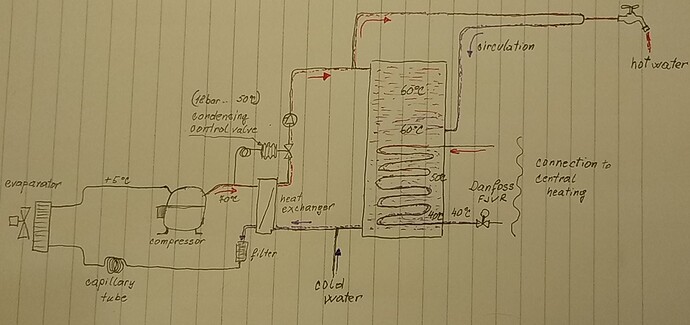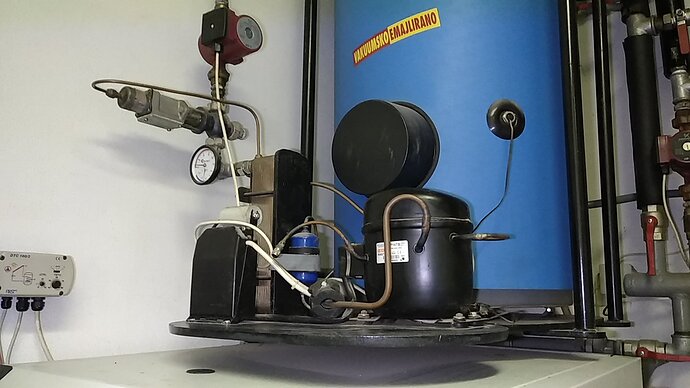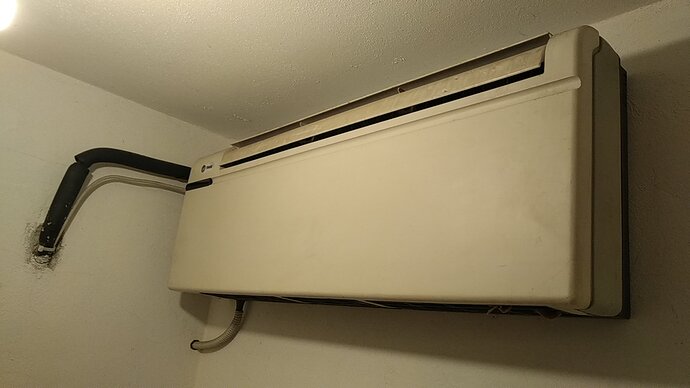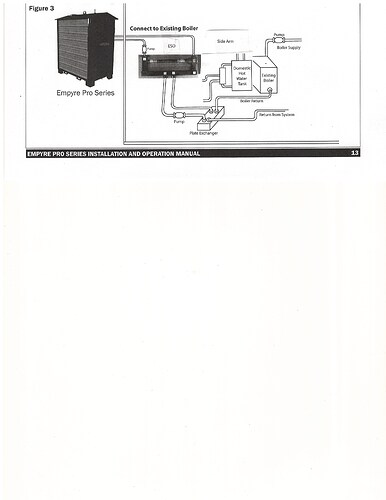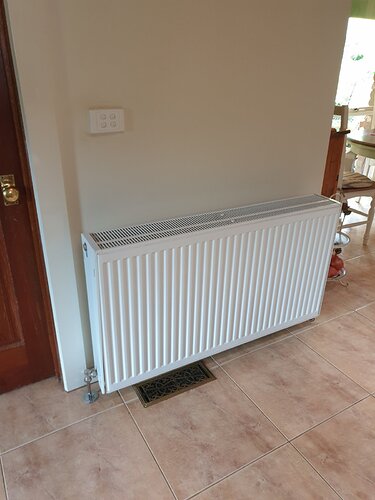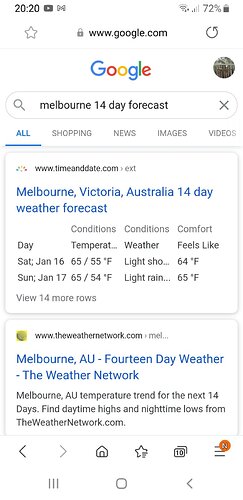The connection to heat exchangers . The plumber told me by his removing so much insulation I was only going to heat basement . I had to un mount pex re wrap it in insulation and re mount it with much larger brackets . I also used foam tube on free standing pipe . I could use more insulation but I have a working system that heats house and not just basement .
Maybe you can start converting the basement into a wood shop. Once the power tools drive her out of the house you will be half way there…
Then again maybe this is one of those times when you shouldn’t take advice from the single guy. 

Hi Jan, because I write more slowly and I still use a translator, my answer is late. This heat pump system is used to heat domestic hot water and cool the pantry in summer, I am attaching a sketch and pictures below
That is very clever J.O.
Using refrigerant concentrated and pumped heat for your domestic water.
Saves some the summer boiler stoking, eh.
Regards
Steve Unruh
Very clever indeed. That’s what I call hitting two birds with one stone. I’m impressed.
I rarely need cooling and the solar panels cover 90% of my domestic hot water need during summer. I cheat and top off the ramaining 10% with electric to save on complexity. I sometimes even bring my soapbox down to the river 
No summer stoking. As long as there’s no house heating needs I don’t bother. Makes first lightup in the fall so much more fun.
To Americans this sounds funny. Here politicians used to stand on a soapbox to harangue people. Are you trying to get the fish vote for you? ![]()
Rindert
Rindert, I had no idea.
Saving on hot tub water was what I had in mind and fish will probably be scared away (or float away - belly up) 
My outdoor wood boiler holds 435 L Tone has over 2000 L thermal storage tank . I keep a fire going for days draft blower and flap valve shuts at 180 F and does not resume until reaching 169 f .
I had to add thermostat 24 volt relay to shut off pump to heat exchanger to keep house from over heating and this strands heat in boiler . Tone must have some thermostat control . If he does not need heat he does not have fire . I had put shop vac under grate and was running motor from wood gas in boiler while the house was drawing no heat . when I saw temperature in non pressurized boiler full of antifreeze was over boiling point I ran inside and shut valve to heat exchanger . Inside pressurized propane boiler does have over temperature over pressure relief valve I just did not want it to vent or stress system when pump started drawing heat .
Hi Henry, as I understand you you have two boilers, the outer one on wood connected to the storage tank and the inner one on propane, but I can hardly comment on anything, because I can’t imagine a sketch of a hydraulic connection from your words, if you attached a sketch, it would be good a picture says more than a thousand words.
outside wood boiler is not pressurized . I have no storage tank . Side arm heat exchanger for domestic hot water is connected between pump and heat exchanger .
Your system is much much more efficient . Mine works
If i could pick you more experienced hydronic heating guys brains for a moment i have a condition on my wood heating hydronic system that the guy who installed it did not explain to me very well and i think its because he does not fully understand himself .
I had a brand new system 2 years ago of a 30kw wood heater with "wetback " inside that heats water just for radiators , its an open system with a expansion tank up in the loft above where the fire is and the circulating pumps are down in the basement along with the manifolds to send the water off to various radiators through out the house the problem i have is that i only ever get the top half of the radiators heating up , i looked up symptoms for that on line and all i came up with are blocked dirty radiators , but that cannot be the case as they are all the same hot on top cold on bottom , the guy that fitted it was supposed to come back and look at it last year but its been dragging on now for so long , by the way his reason for it is not enough pressure , well he fitted the standard central heating pumps in fact he fitted 2 of them 1 comes on when water reaches 40 degs in the expansion pipe to the header tank and the other one is on a thermostat for central heating temps in house .
If you cannot visualize what i have i could try with a drawing to show you my set up , but it wont be pretty 
Dave
Dave can you take a photo of the radiators in your system and post it. I am confused by the description of them. It almost sound like the old cast iron steam radiators. If that is the case they won’t heat right on a boiler 180F or approximately 82C just isn’t hot enough for those. I used the simple baseboard heater copper pipe with aluminum fins. Those work well with water that is min 165F ideal is 180F.
But below 165 mine where useless there simply wasn’t enough thermal delta to heat the house regardless of how much flow I used. I think the radiator simply didn’t get hot enough to draw the air through it at lower temperatures.
Dan they are pressed steel they are also 3 times the thickness as single radiators that means that this one radiator is around a 4kw output , i have another 6 all around the same size
43 x 24 x6
Dave
Well I have never seen a radiator like that. But my first reaction looking at it is that it would take alot of flow to heat that up to 180F. I think I would check the difference between the inlet and outlet temperature on the radiator my guess is you will find that it is simply dropping the temperature of the water faster than the circulation pump can keep up with.
So you are not supplying it with enough hot water to get 4kw output. I am sure Google could help calculate the flow rate required of water for that output with a given delta across the radiator. IIRC and it has been over a decade since I has forced hot water heating my system with baseboard around the entire house would see a 5 degree F drop from the inlet to the outlet of the heating loop. Yes being a controls engineer I designed the system with thermal monitoring and a plc to control the zone pumps. My mistake was not forcing the plumber to install zone valves it would auto syphon through parts of the house I didn’t really want that much heat in.
my gas valve went out and I needed to heat house . It was not that cold out . I removed the gas valve and igniter from stove and had boiler running on one burner . I had water temperature of 100 f . Have replacement valve have normal operation . Please do not attempt to do this your self .
You never seen radiators like that  well when the old cast iron ones where were all modernized in the late 60’s these were what replaced radiators in the UK Europe and Australia homes and factory’s .
well when the old cast iron ones where were all modernized in the late 60’s these were what replaced radiators in the UK Europe and Australia homes and factory’s .
There is little a temp drop of around 2 degs between the input and output of the radiator pipe in the photo and a temp difference of maybe 18degs C from the hot and return cold line at the back of the fire .
Dave
Is the pipe grid in the radiator horizontal or vertical? Hard to picture how the top half of the radiator would be hot but not the bottom, especially if the pipes were vertical. Does the water enter and exit at the bottom? You may have to call Sherlock Holmes.
Hi Tom , pretty sure the internal pipes are vertical and yes flow in / out is from the bottom .
the triple one in this short video would be like mine
Dave
Dave, I think we can all agree lack of flow is the reason for your radiators being only top half warm. Problem is what’s restricting it.
Could be air blocking the flow and you need to bleed, but since all radiators act the same that’s probably not it, unless air is caught somewhere in the main manifold.
I don’t know if you’re using induvidual thermostates on the radiators, but they are usually a pita. But again, all radiators act the same - that’s not it.
Up here we use mainly top inlet-radiators, but watching the video that popped up after watching yours, it appears your type may have a second flow restrictor valve. Could it be those valves are factory set?
Unfortunately my phone (not me) lost the video, but it showed a capped valve on the radiator outlet. Removing the cap that valve could be turned with a tool.
Btw Dave, if I’m not incorrectly informed you should have summer by now down under. Do you really need heat this time a year?
It’s -16C here this morning. Radiator flows ok.
Hi Jo , well can you tell the powers that be that its summer then please .
Now minus say 4 degs off that because i live half way up a mountain where its a lot colder and wetter and that was my summers day today wet and cold !
So as it was not bitter freezing cold but cold enough to light the fire that’s what i did today ,just so i could have a proper play with it .
You are correct as far as the rad valves are concerned it is a flow problem for sure and i think i have pin pointed it down to balance of all the rads around the house , at first it does not look like i have a Lockshield valve on the return side of the radiator , but on closer inspection it look like i must have one of the new types that have a hidden adjust knob , i just never seen one before so i will phone up the guy that fitted it tomorrow and disturb him on his day off and ask him to make 100% sure before i go moving it , because i know for sure he did not balance all the rads for temps as it would have meant him hanging around for an hour or two till the fire got up to full temp when he first installed it all , so i am glad i asked the group the question now as it made me look more closely at the system , and i went around closing off all the rads and one by one opening them and still the bottom bit was cold , so that means the Lockshield valves are wide open and not restricting the flow and allowing the rads to soak heat up fully , adjusting the flow side of the rads only limits the amount of water passing through it so does not help heating up the bottom at all .
Anyway i am closer to the root of the problem now and i think if the Lockshield is not the problem then it must be a faulty pump , but then again i do run 2 pumps so imight have to wait till he gets round to looking at the system .
Dave
